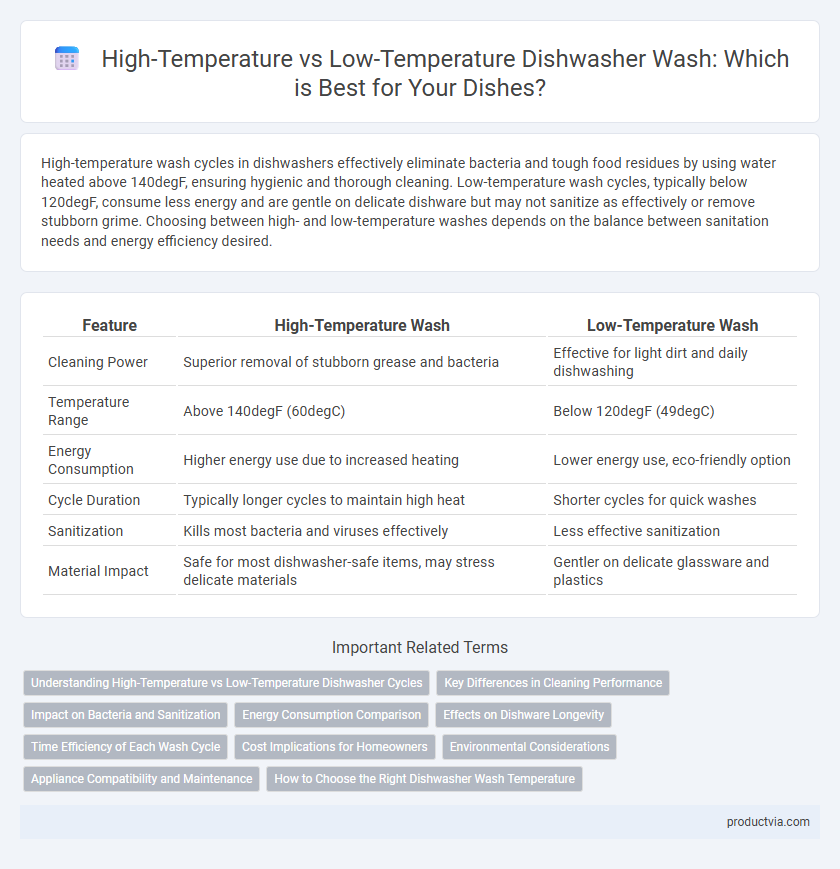High-temperature wash cycles in dishwashers effectively eliminate bacteria and tough food residues by using water heated above 140degF, ensuring hygienic and thorough cleaning. Low-temperature wash cycles, typically below 120degF, consume less energy and are gentle on delicate dishware but may not sanitize as effectively or remove stubborn grime. Choosing between high- and low-temperature washes depends on the balance between sanitation needs and energy efficiency desired.
Table of Comparison
| Feature | High-Temperature Wash | Low-Temperature Wash |
|---|---|---|
| Cleaning Power | Superior removal of stubborn grease and bacteria | Effective for light dirt and daily dishwashing |
| Temperature Range | Above 140degF (60degC) | Below 120degF (49degC) |
| Energy Consumption | Higher energy use due to increased heating | Lower energy use, eco-friendly option |
| Cycle Duration | Typically longer cycles to maintain high heat | Shorter cycles for quick washes |
| Sanitization | Kills most bacteria and viruses effectively | Less effective sanitization |
| Material Impact | Safe for most dishwasher-safe items, may stress delicate materials | Gentler on delicate glassware and plastics |
Understanding High-Temperature vs Low-Temperature Dishwasher Cycles
High-temperature dishwasher cycles typically operate at 140degF to 160degF, offering superior sanitization by effectively killing bacteria and dissolving grease. Low-temperature cycles run around 110degF to 130degF, consuming less energy and being gentler on delicate items but may not eliminate all germs as efficiently. Choosing between high-temperature and low-temperature wash cycles depends on the level of cleanliness required, energy preferences, and the types of dishes being cleaned.
Key Differences in Cleaning Performance
High-temperature wash cycles in dishwashers typically reach temperatures above 140degF (60degC), effectively removing tough grease, kill bacteria, and sanitize dishes for superior hygiene. Low-temperature washes operate around 110degF (43degC), using longer wash times and energy-efficient settings that are gentle on delicate items but may leave behind more residues and less effective sterilization. The choice impacts cleaning performance significantly: high-temp washes deliver stronger cleaning power and sanitization, while low-temp cycles prioritize energy savings and protection of fragile dishware.
Impact on Bacteria and Sanitization
High-temperature wash cycles in dishwashers typically reach temperatures above 150degF (65degC), effectively killing more bacteria and ensuring superior sanitization compared to low-temperature washes, which operate below 120degF (49degC). The elevated heat in high-temperature cycles breaks down grease and biofilms, reducing the risk of contamination and promoting hygienic dishware. Low-temperature washes may save energy but often require stronger detergents or longer cycles to achieve similar microbial reduction, potentially compromising pathogen elimination.
Energy Consumption Comparison
High-temperature wash cycles in dishwashers consume significantly more energy, often using up to 30% more electricity than low-temperature wash cycles due to the additional heating required to reach 140degF (60degC) or higher. Low-temperature wash cycles typically operate around 110degF (43degC), reducing energy consumption while still effectively cleaning lightly soiled dishes when paired with modern detergents and soil sensors. Choosing low-temperature settings can lead to substantial energy savings without compromising cleaning performance for everyday dishwashing needs.
Effects on Dishware Longevity
High-temperature wash cycles, typically ranging from 140degF to 160degF, provide superior sterilization but may accelerate wear on delicate dishware, such as fine china and plastic items, by causing faster degradation and color fading. Low-temperature wash cycles, usually below 130degF, extend the lifespan of sensitive materials by reducing thermal stress, although they may compromise sanitization effectiveness against bacteria and stubborn stains. Selecting the appropriate wash temperature balances effective cleaning with minimizing long-term damage, enhancing overall dishware longevity.
Time Efficiency of Each Wash Cycle
High-temperature wash cycles in dishwashers typically take longer, often ranging from 90 to 120 minutes, to ensure thorough sanitization and optimal removal of stubborn grease and bacteria. Low-temperature washes are faster, usually completing within 30 to 60 minutes, making them more time-efficient for lightly soiled dishes but less effective for heavy-duty cleaning. Choosing between high and low-temperature cycles depends on balancing time efficiency with the level of cleanliness required.
Cost Implications for Homeowners
High-temperature dishwasher cycles consume more energy, leading to higher electricity bills for homeowners compared to low-temperature washes. While high-temperature washes offer superior sanitization and faster drying, low-temperature cycles reduce energy costs and extend appliance lifespan by minimizing thermal stress. Choosing low-temperature washes can yield significant long-term savings, especially in households with frequent dishwashing needs.
Environmental Considerations
High-temperature wash cycles in dishwashers typically consume more energy, increasing the carbon footprint compared to low-temperature washes that use less electricity. Low-temperature wash options help reduce greenhouse gas emissions by lowering energy consumption, making them more environmentally sustainable. Energy-efficient dishwashers often incorporate eco-friendly wash modes that balance cleanliness with minimal environmental impact.
Appliance Compatibility and Maintenance
High-temperature wash cycles in dishwashers are ideal for heavy soiling and sanitize effectively, but they require appliances designed to withstand elevated heat, ensuring durability and preventing component damage. Low-temperature wash cycles are compatible with a broader range of dishwasher models, including those with plastic parts or delicate coatings, promoting energy efficiency and reducing wear over time. Proper maintenance involves selecting the appropriate wash temperature based on appliance specifications to optimize performance and extend the lifespan of internal elements such as seals and heating elements.
How to Choose the Right Dishwasher Wash Temperature
Choosing the right dishwasher wash temperature depends on the type of dishes and level of soil; high-temperature wash cycles, typically around 140degF to 160degF, effectively sanitize and remove tough grease and bacteria, making them ideal for heavily soiled cookware and baby bottles. Low-temperature washes, usually between 110degF and 130degF, consume less energy and are suitable for delicate glassware and lightly soiled items to prevent damage. Consider the dishwasher's energy efficiency ratings and specific cycle options to balance cleaning performance with eco-friendliness and care for different dish materials.
High-Temperature Wash vs Low-Temperature Wash for Dishwashers Infographic

 productvia.com
productvia.com